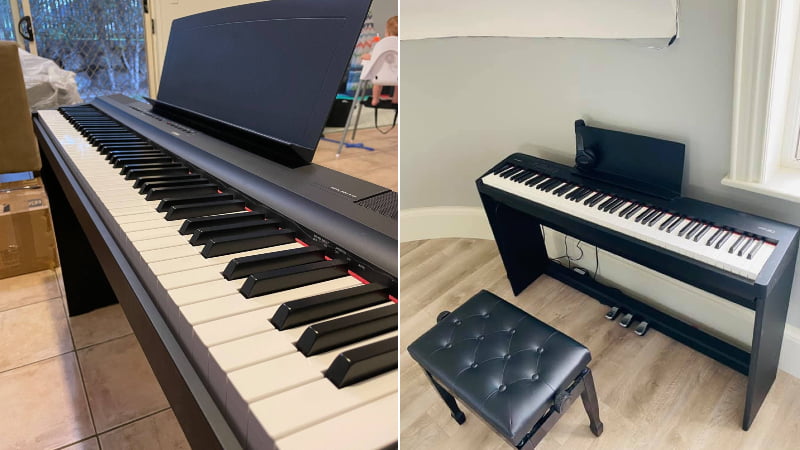When comparing the Yamaha P125 vs Roland FP30, I had a whole lot of fun. These are two great pianos for beginner and novice pianists alike, each with its own set of features and benefits. However, after a close battle, the Yamaha P125 was the winner.
After tons of tests, I found that the Yamaha P125 offers better tones and voices than the FP30. This is likely because the samples came from real Yamaha pianos that are famous worldwide. On top of that, the P125 has a couple of great effects and features that make it a joy to play.
On the other hand, it’s hard to deny the superior feel of the Roland FP30’s keys. It also comes with MIDI connectivity, which is a great feature for producers. Since these two pianos each came with great features that any musician would enjoy, creating this in-depth comparison was a no-brainer.
Yamaha P125 vs Roland FP30: Comparison Chart




Last update on 2025-07-03 / Affiliate links / Images from Amazon Product Advertising API
Yamaha P125 vs Roland FP30: Diffrences
As I mentioned earlier, this was a very tight-knit battle. To find out the better option, I had to directly compare the features of either piano. And at the end, the Yamaha P125 narrowly edged out the FP30 by 4-3 because of its superior tone generation and tone quality.
Feel
The winner: Tie
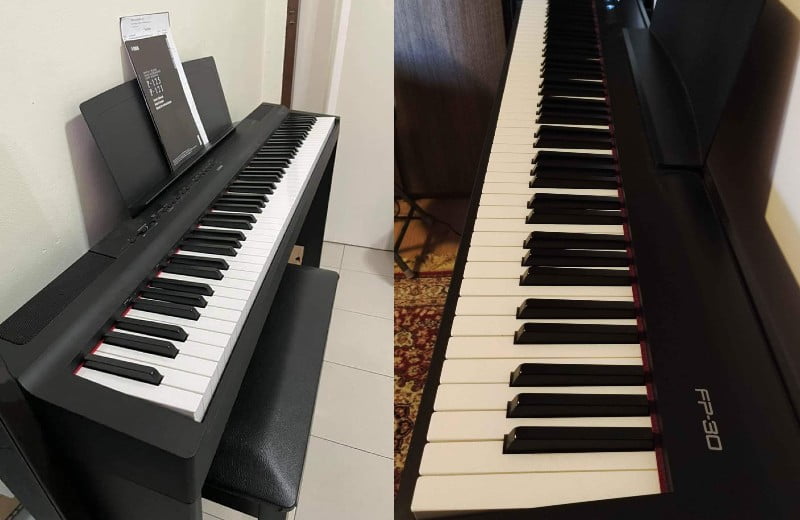
When it comes to piano feel, these two instruments are tied. Each of them has its own advantages as the Yamaha P125 offers slightly better hammer action, but on the other hand, the Roland FP30 has a better key texture.
Hammer Action
Both of these pianos have progressive hammer action. Since they have fully-weighted keys, progressive hammer action means that the left side of the piano will have heavier keys than the right side. This is to mimic the actual feel of an acoustic or grand piano. And while they use the same concept, this is accomplished through different means.
The Yamaha P125 uses the Yamaha GHS (Graded Hammer System) for the keys, while the Roland FP30 uses PHA-4 (progressive hammer action 4). Both of these options are great at mimicking the feel of an acoustic piano. However, after extensive tests, I found that the Yamaha P125 offers a more realistic feel, although admittedly, you’d need to have a lot of experience with acoustic pianos to really tell the difference.
So, while the Yamaha P125 edges out the FP30 in this regard, keep in mind that it’s not by much and it was a very close fight.
Key Texture
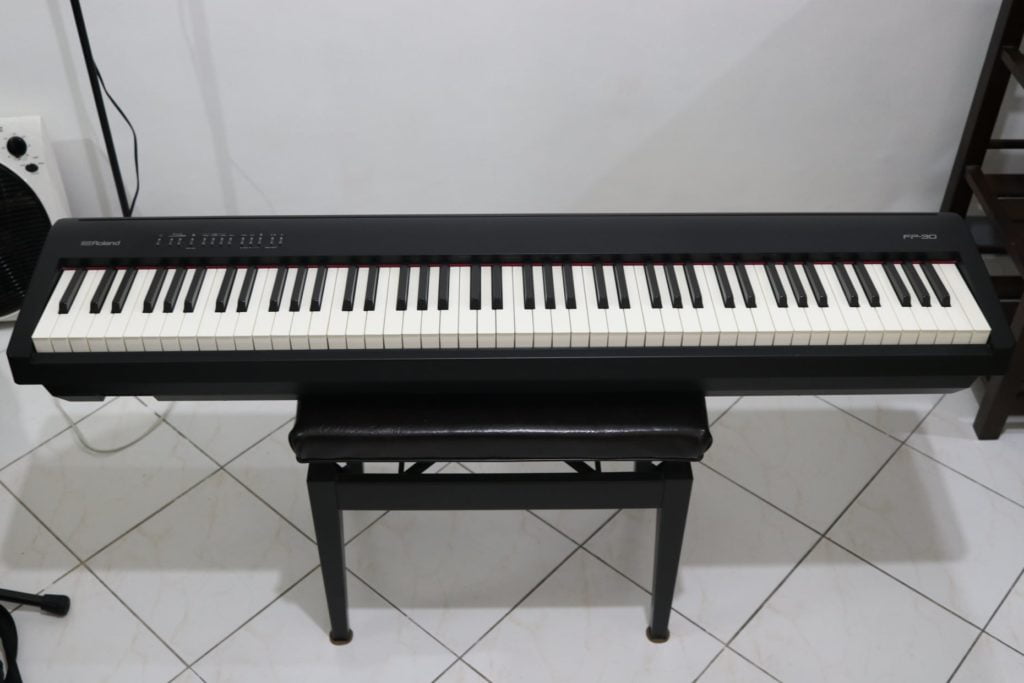
When it comes to key texture, I had to declare the FP30 the winner. This is because the Yamaha P125 only has plastic keys with no texture to mimic the feel of ivory. While this is barely noticeable, it does make for a plastic-like feel that doesn’t resemble the texture of an acoustic piano.
On the other hand, the FP30 has keys specifically designed to mimic how an acoustic piano feels. This is by providing a thin coating on top of the keys that give it a signature texture. And after a couple of tests, I found that this actually makes a small difference when it comes to playability.
Since the Yamaha P125 has better hammer action and the Roland FP30 has better key textures, these pianos are definitely tied when it comes to the feel and playability of the instruments.
Tone
The winner: Yamaha P125
Comparing the tone of these two pianos was very tough. Since they’re in the same price range, they both provide great piano tones that would satisfy any novice or beginner. However, the Yamaha P125 has a slight edge in this regard because of higher quality samples and more robust effects.
Tone Generator
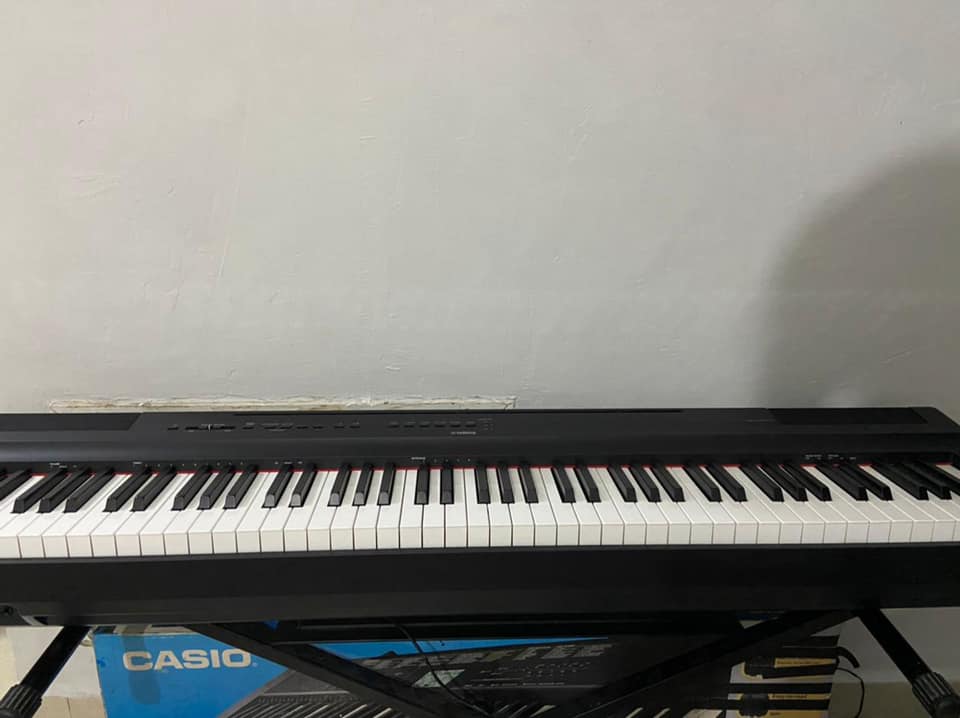
Both pianos use sampling technology to generate tones. The Yamaha P125 uses the Pure CF Sound Engine, while the Roland FP30 uses the SuperNATURAL Piano Sound Generator. Both of these technologies work in a similar way, where a specific key triggers the piano to play a sample of an instrument. However, these two work in slightly different ways.
The SuperNATURAL Piano Sound Generator works by sampling high-quality pianos with state of the art technology. What sets this process apart from the rest is that Roland makes sure to record the samples with natural decay. This makes for a crisper and more natural tone, especially compared to other pianos that use artificial decay.
With the Pure CF Sound Engine, you play samples directly recorded from the Yamaha CFIII Concert Grand Piano. This is one of the most famous pianos on the market and is widely known for having an unmistakable tone. Yamaha recorded these sounds using the best technology and applied digital filters to make the tone as natural, crisp, and clear as possible.
Keep in mind, tone is very subjective. However, after listening to these pianos over and over again, I found that the Yamaha Pure CF Sound Engine produced more accurate tones than the SuperNATURAL Piano Sound. This could be due to better recording conditions, or the fact that the Yamaha tones come from the Yamaha CFIII piano, which is one of the most sought-after instruments in the piano world.
Sound Library
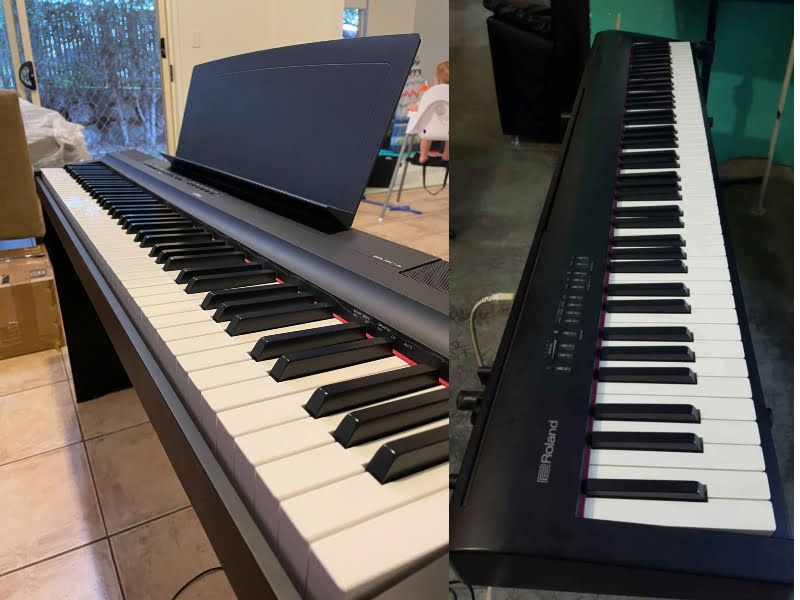
When it comes to the sound library, these two pianos are definitely tied. While the Roland FP30 has way more voices, the Yamaha P125 offers higher quality tones. And since the P125 comes with 24 unique voices, you still have a lot of room to experiment with different sounds.
When comparing the sound quality of these two pianos, it really boils down to what you need and want from your instrument. If you prefer quality over quantity, the Yamaha P125 has the voices for you, but if you want more versatility while sacrificing a bit of clarity and crispness, the Roland FP30 will serve you very well.
Effects
In terms of effects, the Yamaha P125 is the clear winner. With the Yamaha option, you get reverb, IAC, damper control, and sound boost effects. This gives you a whole lot of control over the sound and tone of your piano, which can come in handy for experienced pianists. One downside to this is that if you want damper control, you may need to buy a separate pedal for that. With that said, you can easily tweak all the effects on the P125 using the partner app or even the instrument’s actual interface.
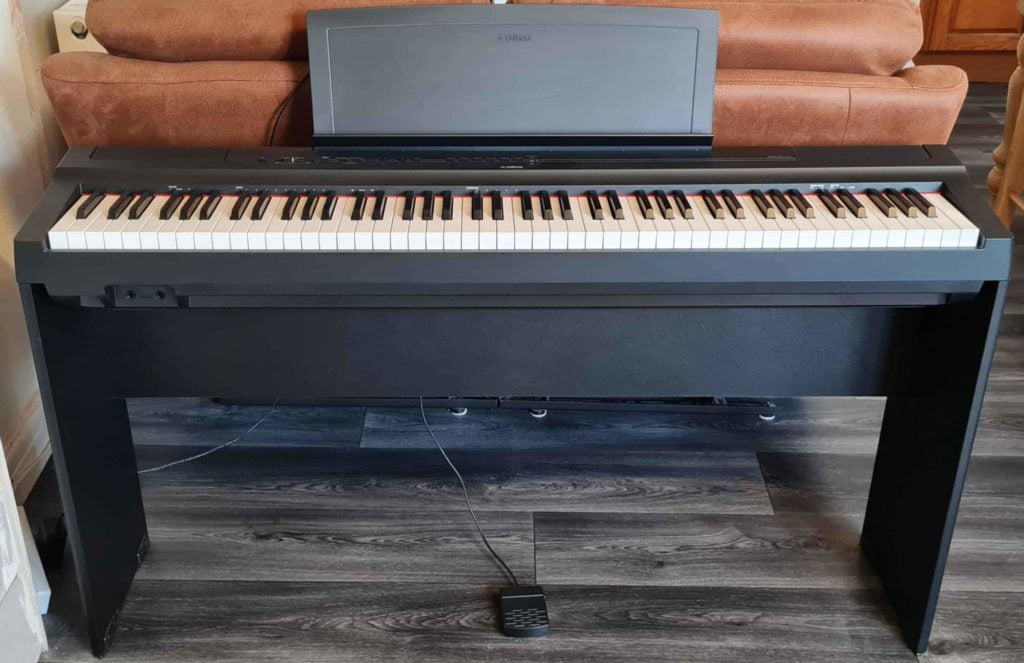
On the Roland FP30, you only get to control Ambience and Brilliance. This doesn’t give you that much control over your tone, especially since ambience and brilliance are very subtle qualities that only experienced pianists or sound engineers are particular about. With that said, most beginners won’t exactly have a need for all these additional effects anyway, so you can treat them more as an afterthought.
However, if piano effects are a very important quality for you, then you might be better off with the Yamaha P125 as it comes with more effects and more control over the effects than the Roland FP30.
Sound System
The winner: Tie
This is another aspect in which these pianos are tied, and not exactly in a good way. Both of these instruments come with relatively tiny speakers, both pianos feature 4 and ¾’’ speakers. While these speakers are large and loud enough for solo practice, if you’re playing with multiple musicians, you might have a hard time getting heard. So, in that case, you might need to plug into an additional amp or soundsystem.
When it comes to plugging into an external sound system, the P125 has a slight edge because it has ¼’’ outputs. On the Yamaha P125, there are separate left and right outputs, so you can plug into a stereo sound system and also use the right output if you want to play mono. With the FP30, you also have a ¼’’ output, but it is only mono, giving you less versatility.
Piano Features
The winner: Tie
I wasn’t lying when I said it was a pretty close battle between these two pianos. When comparing the different piano features they had, each piano had its own set of advantages, which is why they are tied in this aspect.
Playing Modes
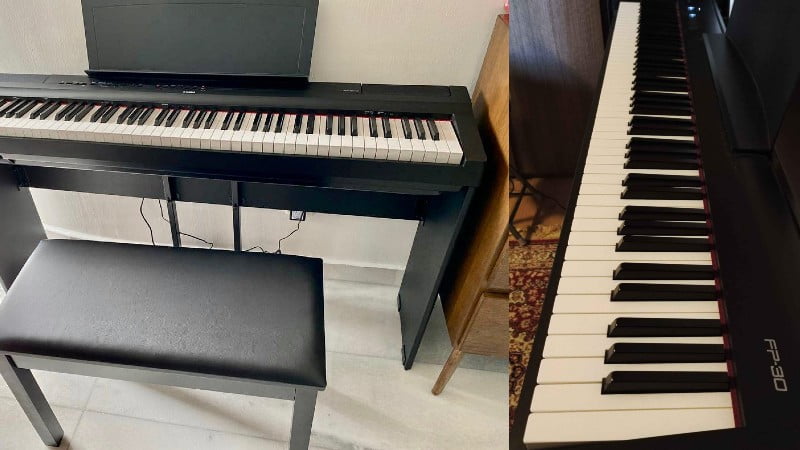
This is an area where the two pianos are very similar. They both have duo, dual, and split modes, though they have different names for it. Duo mode is where the piano is divided into two tiny pianos. This is great for lessons as teachers and students can play the same thing at the same time without having to cross over each other. This feature is present on both pianos, but it’s called Twin Piano mode on the Roland FP30.
Dual mode is sometimes referred to as layering mode on the Yamaha P125 and is also present on the FP30. This mode allows you to blend two different voices together, creating a unique tone. This is great for experimentation or even live performances, and the feature is easy to use on both models.
Lastly, we have split mode. This is a great feature for those who perform with other musicians or as a solo act. In split mode, you can divide the piano into two, where each plays a different voice. For example, you can have a bass on the left side and an organ or synth on the right, allowing you to play rhythm and melody parts at the same time. This gives the illusion of playing two instruments at once, which has tons of applications if you’re a serious pianist.
Polyphony
In terms of polyphony, the Yamaha P125 has a slight edge. With a maximum polyphony of 192 voices, you can play very wide and spread out chords with lots of notes on this instrument without worrying about losing clarity. Even with very dense chords, this piano plays the notes clearly because of its high polyphony.
On the Roland FP30, you only have a maximum polyphony of 128. While this is significantly less than the P125, it doesn’t mean it’s worse. While you will lack some of the clarity you get with the P125, you can play the same dense chords with the FP30 without having to worry about it sounding bad.
Recording
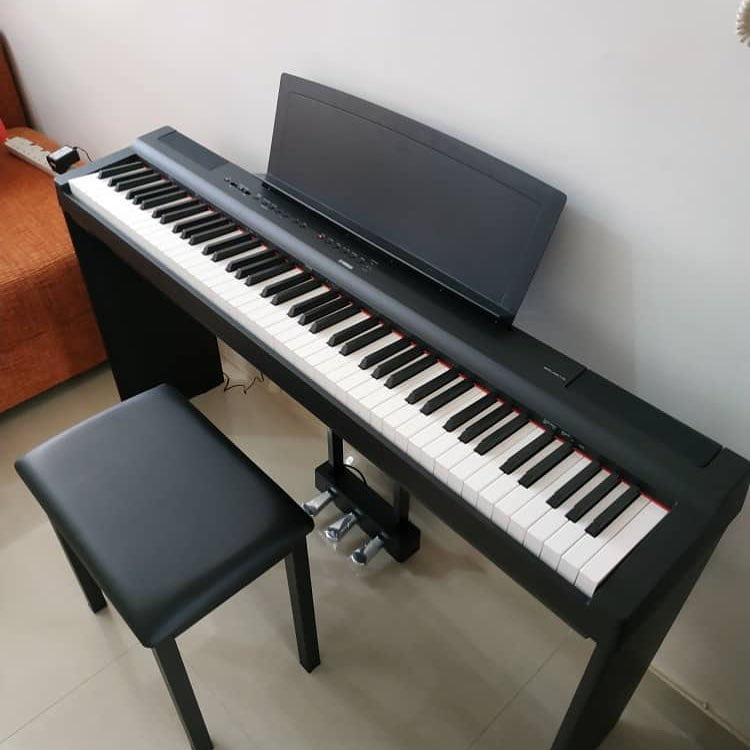
Both of these pianos come with recording options. This is great if you’re a composer or even a beginner pianist trying to listen to their own playing. However, again, the Yamaha P125 has a slight edge in this regard. This is because the Roland FP30 only features one-track recording while the Yamaha P125 features two-track recording.
So, on the P125, you can record multiple layers and create beautiful sounds and compositions. With that said, these aren’t exactly recording devices, so if you want studio-quality recordings, you will still need to head over to a professional recording studio.
Connectivity
When it comes to connectivity, the Roland FP30 is the winner. This is because the Yamaha P125 barely has any connectivity options aside from the partner apps. While they are useful, most pianists and users report that they don’t use the apps that much to tweak the sound and settings of their piano.
The Roland FP30, on the other hand, features MIDI and BlueTooth connectivity. This allows you to use the piano as a MIDI controller for virtual instruments or even piano lesson apps. However, keep in mind that the BlueTooth feature may not be available depending on your location.
Yamaha P125 vs Roland FP30: The Similarities
One of the reasons it was so fun comparing these instruments was because of their similarities. These pianos are both in the same range when it comes to quality and price. If you’re a beginner or novice pianist, either of these options will serve you well.
They both feature a variation on progressive hammer action, have full-key keyboards, and are relatively portable digital pianos that you can bring with you to jams with friends, performances, and even piano lessons.
Both pianos also feature small speakers that are admittedly lackluster, but since you can connect them to external sound systems, this isn’t too much of a problem. Since these are two similar pianos, they would make great picks for just about any beginner or novice pianist out there, though I would have to say that the Yamaha P125 offers better tones, which is why it’s my preferred pick between the two.
Quick Rundown of the Yamaha P125
- A fully weighted digital piano with 88 full sized piano style keys
- GHS weighted action is heavier in the low keys and lighter in the high keys, just like an acoustic piano
- The pure CF sound engine faithfully reproduces the tone of the acclaimed Yamaha 9 feet CFIIIS Concert grand piano; Tempo range: 5 to 280
- Split mode lets you play a different voice with each hand; Tuning: 414.8 440.0 to 446.8 hertz
- USB to host connectivity with MIDI and audio transfer means you only need 1 cable to connect to your music making software
Last update on 2025-07-03 / Affiliate links / Images from Amazon Product Advertising API
Quick Rundown of the Roland FP30
- Rich, responsive tone from Roland renowned supernatural piano sound engine
- 88-Note Phat-4 standard keyboard provides authentic piano touch for maximum expression
- Powerful amplifier and stereo speakers deliver impressive sound
- Headphones output and quiet keyboard action allow you to enjoy playing at any time without disturbing others
- Optional matching stand and three-pedal unit provide a classic piano look and Enhanced functionality, including hands-free page turning with some sheet music apps
Last update on 2025-07-04 / Affiliate links / Images from Amazon Product Advertising API
Product Video:
Related Articles to Yamaha P125
- Yamaha P150 vs P125: The Battle of the P-Series Models
- Yamaha P125 vs CLP 625: Can a Beginner’s Digital Piano Match the Clavinova?
- Yamaha P125 vs Roland FP 60: Which is the Better Investment?
- Yamaha P-121 vs P-125: Finding the Best Portable Yamaha Piano
- Yamaha P125 vs Korg LP 380: Which Piano Is Better for Your Needs?
- Yamaha P125 vs P85: Can the Outdated Digital Piano Beat the Newer One?
- Yamaha P125 vs DGX 670: Which Piano Comes Out on Top?
- Yamaha P125 vs Korg SP 280: Which is the Better Beginner’s Digital Piano?
- Yamaha P-255 vs P-125: Finding the Better Option for Beginners
- Yamaha P125 vs YDP S34 Comparison: Does the Portable P125 Hold Up Against a Console Digital Piano?
- Yamaha P125 Vs YDP 164: Should You Get A Console Or Digital Piano?
- Yamaha YDP 103 Vs P125: Should You Get a Portable or Console Digital Piano?
- Yamaha P125 Vs Kawai ES110 Comparison: Which Is The Best Portable Digital Piano
- Yamaha P125 vs Casio PX S1000: Which Digital Piano Is Worth Your Money?
- Casio PX-870 Vs Yamaha P-125: Should You Get A Portable Or Console Digital Piano?
- Alesis Recital Vs Yamaha P125: Which Is The Right Pick For You?
- Yamaha P45 VS P115: Which P-Series Newbie Gives You More Value for Money?
- Alesis Recital Pro vs Yamaha P125 Comparison: Which Is The Best Portable Digital Piano?
- Alesis Prestige Artist vs Yamaha P125 Comparison: Why the Yamaha P125 Is the Better Investment
- Yamaha P125 vs Casio PX-770 Review: Why the Yamaha P125 Beats Out the Casio Console Digital Piano
- Yamaha P125 vs DGX 660 Comparison: Can the P125 Hold Its Own Against the DGX 660?
- Yamaha P125 vs Roland FP-30X Review: Why the Roland FP-30X Comes Out On Top
- Yamaha P125 vs P515 Review: Why the Yamaha P515 Is the Better Investment
- Yamaha P115 vs P125 Review: Can the P125 Beat Out Its Predecessor?
- Yamaha P45 vs P125: Why the Yamaha P125 Is the Better Pick for Pianists
- Yamaha P71 vs P125: Why the Yamaha P125 Is the Better Investment
Related Articles to Roland Fp30
- Alesis Recital Pro vs Roland FP-30: Finding the Best Digital Piano on a Budget
- Yamaha DGX 660 vs Roland FP30: Finding the Best Digital Piano
- Casio PX-870 Vs Roland FP-30: Which Piano Should You Choose?
- Casio PX-770 Vs Roland FP-30: Should You Get A Portable or Console Digital Piano?
References:
- P-125: https://usa.yamaha.com/products/musical_instruments/pianos/p_series/p-125/specs.html#product-tabs
- FP-30 Digital Piano: https://www.roland.com/global/products/fp-30/specifications/
Lulacruza is an electronic folk duo operating at the junction of the hypermodern and the ancient. Our music weaves together hypnotic female singing, South American folk instruments and electronic processing, while channeling pulsating waves from the source of creation.
Lalucruza is also a community where you can connect with other music lovers to collaborate, exchange ideas and share knowledge. A platform for who wants to learns the basics of playing piano, guitar, drum masters’ technique, etc.. is the premise of our website.
